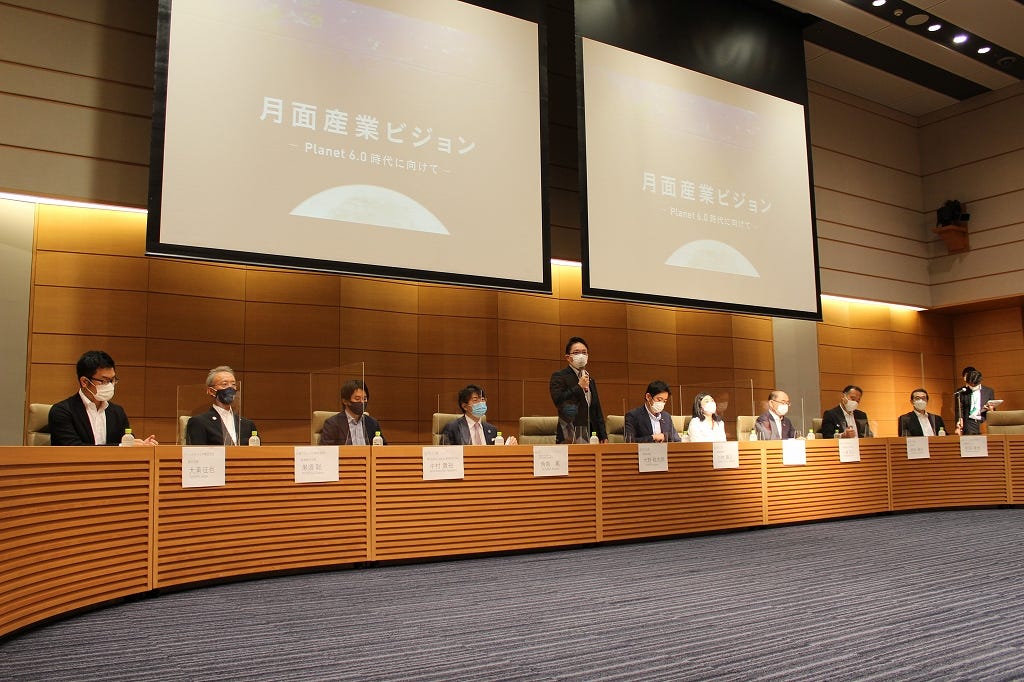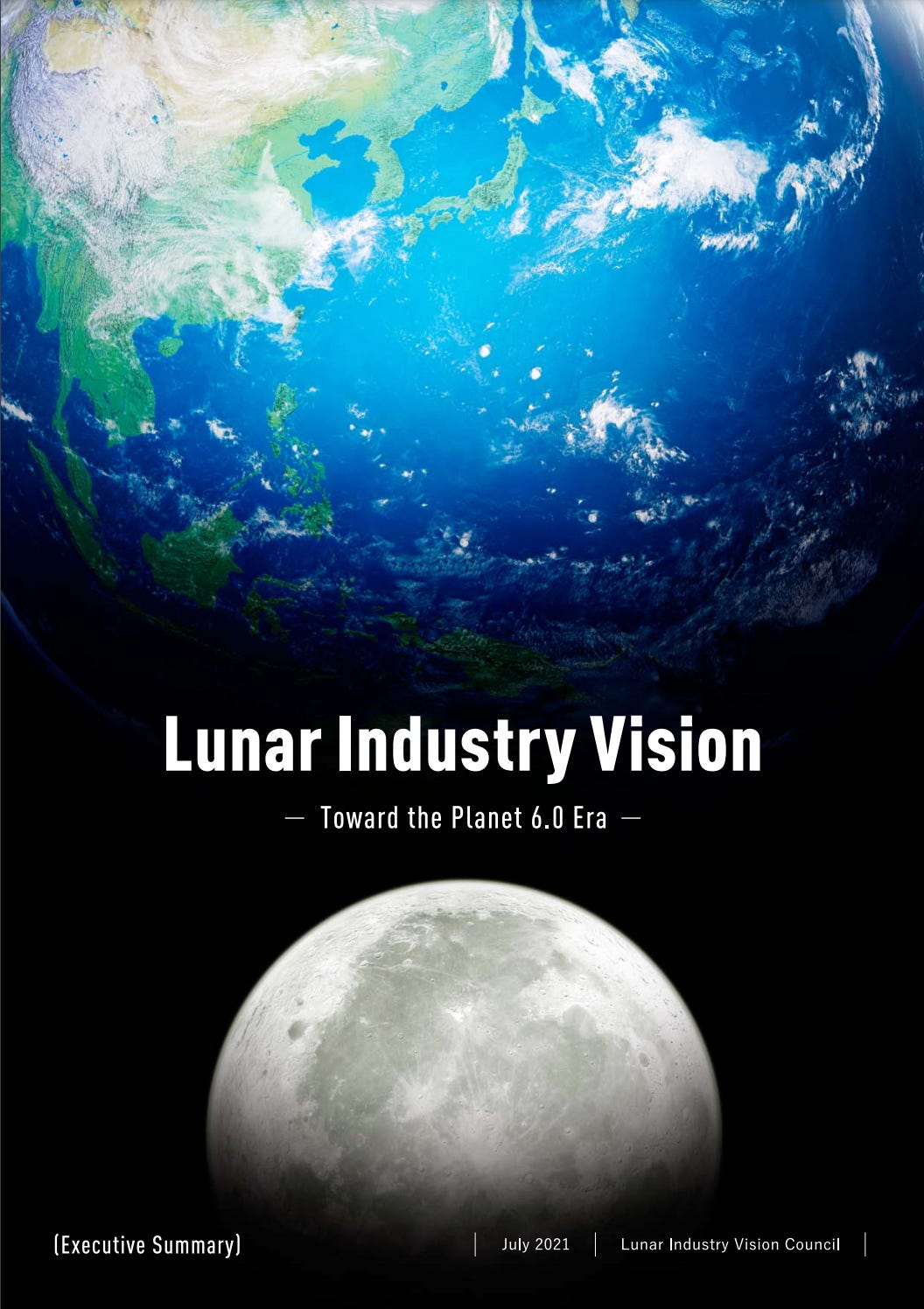Monthly Recap | July 2021
This month focuses on Japan's position in the commercial lunar ecosystem
Japan may be the dark horse in the lunar industrial race
This month, as reported by Bloomberg, a consortium consisting of about 30 Japanese companies, legislators from the ruling political party, and academics from top universities called on the government to foster the creation of a globally competitive lunar industry in Japan.

The working group, called the Lunar Industry Vision Council, submitted a report titled Lunar Industry Vision to the Minister of State for Space Policy. The report included 6 declarations by industry and 7 recommendations to the government.
The group included representatives from firms as diverse as food companies Ajinomoto and Nissin Foods; one of the five major Japanese construction companies, Obayashi Corporation; IT and electronics corporation, NEC; electrical engineering and software company, Yokogawa Electric; and Sony Computer Science Laboratories, among several others.
Inside the report, the companies stated that they will identify “where industry’s strengths are required and/or applicable” to apply toward lunar development. Additionally, it asked the government to assume the procurement of commercial lunar services “as standard practice”; organize its plans for lunar activities “in a visible manner to enhance the foresight of the private sector”; and, “foster an environment that promotes investment into risk-taking companies,” such as capital gains tax exemption for investing in lunar business companies, among other recommendations.

This isn’t the first time non-space companies in Japan have shared a vision for lunar business. In addition to those who joined the Lunar Industry Vision Council, several other Japanese companies have previously announced public plans to support the commercial development of the Moon or start their own lunar businesses:
Shimizu and Kajima Corp., another two of the country’s leading construction companies, have conducted research or shared concepts for a lunar base,1 with the former also proposing a method for solar power generation on the Moon;2
Toyota is developing a pressurized crewed lunar vehicle;3
Bridgestone will support the tire development of the Toyota rover;4
Mitsui Sumitomo Insurance plans to launch the first lunar insurance;5
Sony and Takara Tomy, a toy company, combined their specialties to develop a small lunar rover;6
Misawa Homes is conducting research in Antarctica for lunar habitation;7
Honda is conducting joint research with JAXA on a “circulative renewable energy system” designed to supply oxygen, hydrogen, and electricity for human outposts and rovers;8
NGK Spark Plugs is developing a solid-state battery for usage on the Moon;9
Takasago Thermal Engineering is planning to conduct a water-splitting experiment on the lunar surface;10
and there are many more disclosed and undisclosed examples.
Likewise, Japanese lunar lander company ispace has been a central player in attracting and orchestrating the involvement of non-space companies into the commercial lunar ecosystem.† Companies such as Japan Airlines, Suzuki Motors, Citizen Watch, and Sumitomo Corporation have joined ispace’s commercial program “HAKUTO-R” as corporate sponsors. Several of the companies have contributed to ispace’s missions: Suzuki Motors provided structural analysis for the landing system of ispace’s lander and, recently, Citizen Watch launched limited-edition watch models with the same titanium material the company supplied to ispace for use in its lander. In fact, this month, I was quoted in Campaign and PR Week on this topic.

“…in order to sustain an economy on the moon, and also expand human presence onto the moon and deeper into space, the private sector is going to have to be deeply involved in things like construction and development and energy."
- My comment in the Campaign article
The Japanese government has also been supportive of commercial activity in the area of lunar development. As reported this month in Japan’s largest financial newspaper, the Nikkei, Japan’s Ministry of Internal Affairs and Communications (MIC) announced plans to begin a demonstration experiment to map the location of water on the Moon during the 2021 fiscal year. The ministry already began to solicit proposals from Japanese R&D institutions, offering approximately $2 million (USD) to go toward the widespread exploration of water resources on the lunar surface using terahertz waves; winners will be announced in September or October.
In June, the National Diet of Japan passed a law permitting private businesses to freely engage in the exploration, mining or extraction, storage, processing, and other operations necessary for the development of space resources, such as water, on the Moon.11 In doing so, Japan became the fourth country to pass legislation permitting its private sector to engage in space resources utilization, joining the United States, Luxembourg, and the United Arab Emirates.12
This month, Japan’s Ministry of Economy, Trade and Industry (METI) awarded a contract with a maximum budget of approximately $2.5 million (USD) to GITAI, a Japanese company developing space robotic technology, for the research and development toward the realization of extra-vehicular general-purpose robotic arms and hand technology that can autonomously perform multiple complex tasks on-orbit and on the lunar surface.13 GITAI also announced this month that it would be developing a lunar rover.14
Also this month, JAXA and a spin-off of the Japanese airlines, All Nippon Airways (ANA), kicked off a project to advance robotic avatar technology “to assist astronauts with performing duties in the ISS and future outer space settings, including the lunar surface.”15
The term “dark horse” used in the title of this article would imply there is a competition and an ultimate winner, so maybe it’s not the correct term, but - in my view - Japan is certainly taking the lead among other nations in producing lunar business among non-space companies. Additionally, in doing so, Japan is remaining almost silent or “under the radar” on the global stage. However, I don’t believe this is intentional, but rather a product of language barrier and distribution of information.
For a number of years, I’ve been keenly aware and excited about this scenario, and all the while, questioning why the United States and China seem to either be lagging behind in this area or just lacking the interest. Both countries have communicated visions for a lunar economy, but there have been very few, if any, private sector players - outside of the aerospace sector - rise up to the challenge.
Indeed, as I reported in my May issue, at least one prominent name, General Motors, announced that it will collaborate with Lockheed Martin on a lunar vehicle.16 In early June, a senior executive at Lockheed Martin hinted, “this non-aerospace industry partnership is something I think we’re going to see more and more of as we move into the future.”17 However, no other high-profile initiatives like this come to mind. At least to my knowledge, any other information about non-space American companies eyeing lunar business come in the way of whispers or non-conclusive information.
For example, some well-known American construction and engineering companies periodically show up as participants in workshops, studies and other collaborations with NASA or the lunar scientist community. I’ve personally seen a senior executive from a top American consumer goods company join a panel session about lunar industry creation. However, none of these examples are as direct as the Japanese companies listed above, many of which have publicly announced clear plans to either start lunar business or support the industrial development of the Moon.
Every civilization on Earth has marveled at the Moon and dreamt of visions of human presence there and on other planets. However, there’s a unique type of fascination and unparalleled creativity coming from Japan in relation to industrializing our lunar satellite and bridging the Earth and the Moon into socio-economic harmony.
As someone familiar with the operations of Japanese companies, I’ve long found it intriguing that for a society where industry and government can be so risk-averse, indirect or ambiguous with public statements, often holding back or padding speeches and remarks with safeguards, and unwilling to be the first to do something—often, waiting to follow the United States or Europe in new ventures—Japan is clearly taking the lead in involving leaders in the non-space private sector to, quite literally, develop the infrastructure to enable human presence on the Moon and establish the framework to generate sustainable economic activity there.
I might speculate on the reason for this: On one hand, Japan’s space budget is only a fraction of the United States. Therefore, collaboration with industry might be the natural response to achieve results with limited resources. At the same time, the Japanese government is always on the search for new and innovative fields for Japanese industry to establish or maintain leadership in the world, particularly in the fields of science and technology. And, I’m aware that several companies take on these sorts of ambitious challenges for the other benefits they bring: bolstering innovation and R&D capabilities; appealing to new talent as a recruitment strategy; and, launching “out of this world” advertising campaigns.
On the other hand, in Japanese arts and culture, particularly science fiction content, there’s no shortage of imagination in relation to future societies living on the Moon. This can be seen in popular manga such as Space Brothers and Moonlight Mile and a whole myriad of other space related anime, film, stories, and so on. This pervasive theme in entertainment, enjoyed from youth through adulthood, could be one impetus for Japanese people to readily pursue this next frontier without pause.
It’s common to see slogans and manifestos among Japan’s corporates and government bodies championing the co-creation of a future society. There’s a nationwide appeal for generating the next frontier for human life - on Earth and in space - through the use of AI, robotics, and other technologies, and it almost always encourages broad collaboration across industrial sectors and parts of society, inciting contribution of unique specialities from all who want to participate in the challenge.

Perhaps, in the not-too-distant future, it won’t be so outlandish of an idea to look out the window of a spacecraft arriving at a sprawling lunar city and see a Yoshinoya nestled into the infrastructure, as was shown in the Brad Pitt film, Ad Astra. And, perhaps, that building could have been built by Shimizu or Obayashi, utilizing lunar robots from GITAI equipped with NGK Spark Plug batteries and Bridgestone tires.
† The author of this newsletter is employed by ispace. I do my best to be fair and objective. All opinions and analysis are my own. Read full disclaimer in the newsletter About section.
Japanese general contractors looking to build base on moon; Mainichi Shimbun, Sept 18 2018.
Here's a Climate-Change Fix: a Giant Solar-Power Plant on the Moon; The Atlantic, Dec 2 2013.
JAXA and Toyota Announce "LUNAR CRUISER" As Nickname for Manned Pressurized Rover; Toyota, Aug 28 2020.
三井住友海上とispace、民間月面探査プログラム「HAKUTO-R」のコーポレートパートナーに参加; Nikkei, Feb 22 2019.
Movable housing to be tested in Antarctic for future lunar mission; Kyodo News, Oct 29 2019.
JAXA and Honda to Begin a Feasibility Study on a Circulative Renewable Energy System; JAXA, June 14 2021.
HAKUTO-Rのミッションで月に全固体電池を輸送世界初となる月面での全固体電池の技術実証試験を実施予定; NGK Spark Plug, Feb 22 2019.
高砂熱学工業、日本における月面ビジネスのエコシステム構築に向けた月面産業ビジョンを政学産連携で日本政府に提出; Nikkei, July 13 2021.
Japan passes space resources law; SpaceNews, June 17 2021.
GITAI Starts Development of a Lunar Robotic Rover and Unveils the First Prototype; GITAI, July 26 2021.
avatarin and JAXA Kick-Off Co-Creation Project to Advance “Space Avatar” Technology; JAXA, July 16 2021.
GM’s newest vehicle: Off-road, self-driving rover for moon; Associated Press, May 27 2021.
Lockheed Martin Partners With GM to Make Electric Lunar Rover; Bloomberg TV, June 2 2021.



